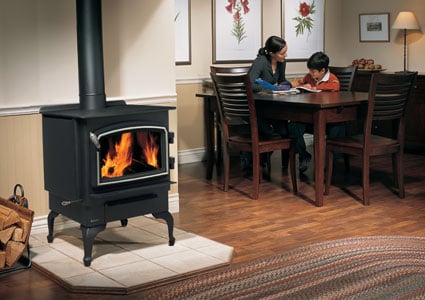
Warner Service knows that many homes in the Frederick area utilize woodstoves and fireplaces to supplement their heating system. While these appliances can provide large amounts of heat and use inexpensive fuels, they can also be a serious risk to your home if not used correctly. That’s why Warner Service put together these 10 Tips for Safe Woodstove/Fireplace Heating to protect your home and keep it comfortable.
1. Only burn firewood and kindling.
It might not seem like that big of a deal to throw a magazine or other small piece of trash you’re found in your fireplace or stove, but these appliances are made to burn only the correct kind of wood. When garbage is burned, dangerous fumes can be produced. In addition, garbage can sometimes burn quicker than wood might, causing more heat than normal to be produced. This increased heat can also damage components of your fireplace, woodstove, or chimney. Log starters are perfect for getting your wood fireplace or stove going, but they burn extremely hot as well.
2. Use Aged Wood
Dry, cured wood that has been split, stacked, and dried for some time will not only catch faster and easier than wet or green wood, but it will also be more safe. If possible cover your log pile, leaving the sides open for air to flow through.
3. Know The Wood You’re Using
Softwoods make great firewood and are generally cheaper than hardwoods, but burn quicker. Hardwoods are more expensive and burn slower, but will be more difficult to start. The best solution is to start a fire with softwood and then use hardwood sparingly, if possible.
4. Clean Your Stove
A clean stove or wood fireplace will ensure your appliance will get warmer and stay warm for longer. Remove soot and clean it on a regular basis as even a few layers of ash will reduce the efficiency. Also, be sure to dispose of your ashes responsibly. Coals can sometimes stay hot for up to two weeks if left in the correct conditions.
5. Shut Your Damper
When you are not using your stove or fireplace, close your damper to avoid warm indoor air from vanishing outside. This can also cause a health risk to those inside, as dangerous materials inside your chimney may re-enter your home’s breathing air.
6. Check For Leaks
Be sure to check both your stove/fireplace and your chimney for any air leaks before lighting your fire. Old or broken seals often cause these leaks, and fixing these issues can prevent heat loss. A top-mounted damper that also functions as a rain cap provides a tighter closure than a traditional damper for your wood fireplace.
7. Keep Your Chimney Maintained
If you have a wood fireplace, then get your chimney cleaned regularly. Fireplace chimneys should be cleaned once or twice a year, and woodstove chimneys should be checked and/or cleaned before each heating season.
8. Check your Chimney Cap
Chimney caps can prevent unwanted debris like dirt, leaves, rain and snow from falling into your chimney. Getting a cap installed is very beneficial and they have side vents so smoke can easily escape. A registered chimney sweep can normally install a stainless steel cap, which is better than a galvanized metal one as it will not rust as easily.
9. Light Your Fire Correctly
Lighting the wood in your stove from the top is normally better as the wood stove will reach its operating temperature quicker, the gases will burn better and will last longer. It is best to build the fire slowly, add more wood as it heats. If you have wood fireplace, keep the damper completely open to increase draw in the early stages for turbulence if you have any issues then you could use a blowpipe.
10. Invest in a Carbon Monoxide Detector
Safety is very important, so always install carbon monoxide detectors and smoke detectors in your home, near your stove or wood fireplace as well as in bedroom areas to protect you and your family from this dangerous gas.
Warner Service knows that every home’s heating needs are different. If you need help optimizing your individual heating system, contact Warner Service today to have a qualified technician get you on the right track to a comfortable, warm Winter.

